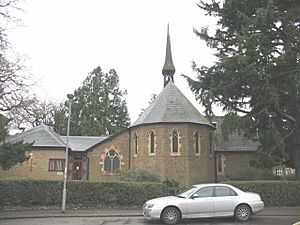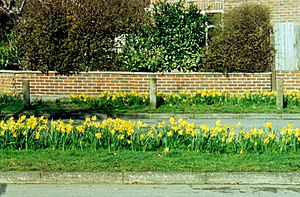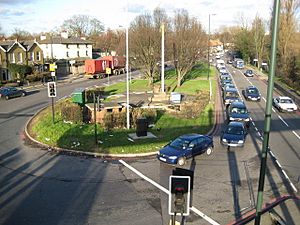Kingston Vale facts for kids
Quick facts for kids Kingston Vale |
|
|---|---|
 St. John the Baptist church, built 1861, is one of the oldest buildings in the district |
|
 By most roads of Kingston Vale are trees and shrubbery and in some cases daffodil-growing grass verges |
|
| OS grid reference | TQ215715 |
| London borough | |
| Ceremonial county | Greater London |
| Region | |
| Country | England |
| Sovereign state | United Kingdom |
| Post town | LONDON |
| Postcode district | SW15 |
| Dialling code | 020 |
| Police | Metropolitan |
| Fire | London |
| Ambulance | London |
| EU Parliament | London |
| UK Parliament |
|
| London Assembly |
|
Kingston Vale is a lively area in south-west London, part of the Royal Borough of Kingston upon Thames. It's a place where people live, nestled between big green spaces like Richmond Park and Wimbledon Common. The main road, the A308, helps traffic move through to the A3, which is a major highway.
Kingston Vale is also known for its beautiful trees and plants. Many roads have lovely grass verges where daffodils bloom in spring. It's a mix of quiet streets and important routes, making it a unique part of London.
Contents
Exploring Kingston Vale's Past
A Glimpse into Early History
Long ago, around 1650, an old inn called the Bald-Faced Stag stood where a modern supermarket is today. This inn was said to be a hangout for a famous highwayman named Jerry Abershawe. Highwaymen were robbers who stopped travelers on roads. Jerry Abershawe was executed in 1795, and his body was put on display nearby.
How Kingston Vale Got Its Name
Before the mid-1800s, the lower part of this area was known as Kingston Bottom. This name appears in old maps and documents from 1791 to about 1850. For example, a will from 1791 mentions a place called Robin Hood in Kingston Bottom.
The name Kingston Vale first appeared in the 1861 Census. By 1891, it was officially called Kingston Vale. This new name sounded much nicer and reflected the area's growing importance.
The Legend of Robin Hood in Kingston Vale
The name Robin Hood has been linked to Kingston Vale for a long time. There's a Robin Hood Gate at nearby Richmond Park, mentioned in records from 1785. Even older records from 1548 talk about "Robynhood Walke."
You can still find Robin Hood Lane and the former Robin Hood Inn (now homes) on maps from 1874. People think this connection comes from the Robin Hood plays and May Day games held in Richmond Park for King Henry VIII centuries ago.
The Story of Kingsnympton Park Estate
The Kingsnympton Park Estate was once a huge property called "The Knoll." It had a large house and big gardens along Kingston Hill, right next to Richmond Park. In 1914, a grand mansion named "Haygreen" was built there. It had its own golf course, lakes, and beautiful gardens.
Later, in 1927, the house was bought and renamed "Kingsnympton." The impressive stone pillars on Crescent Road today mark where the old entrance used to be. Sadly, the estate was bombed during World War II in 1940. After that, the house was taken down, and the land was used to build new homes for people.
Getting Around Kingston Vale
Road Connections
Kingston Vale is located north-east of Kingston. It sits right on the A308 and the A3 London–Portsmouth Road. The closest major road junction is the Robin Hood Roundabout, found at the north-eastern end of the area.
Bus Routes Serving the Area
Kingston Vale has good bus services. These buses connect the area to nearby towns like New Malden and Tolworth to the south. They also link to Kingston and Surbiton to the south-west. To the north-east, you can reach Roehampton and Putney.
Here are the main bus routes:
- 85 – Travels from Kingston to Putney, passing through Norbiton, Kingston Vale, and Roehampton.
- 265 – Goes from Tolworth to Putney, stopping at New Malden, Coombe, Kingston Vale, Roehampton, and Barnes.
- K3 – Connects Esher to Roehampton Vale, via Claygate, Thames Ditton, Surbiton, Kingston, Norbiton, and Kingston Vale.
Train and Tube Access
Kingston Vale doesn't have its own train station. The closest train stations are Norbiton to the south-west and Putney and Barnes to the north-east. You can easily catch a bus from Kingston Vale to these stations.
For the Tube, the nearest station is East Putney. This station is on the District line. You can get there directly by taking bus routes 85 or 265 from Kingston Vale.
 |
Richmond, East Sheen | Roehampton, Barnes, Putney | Wandsworth |  |
| Richmond Park | Wimbledon Common, Southfields | |||
| Norbiton, Kingston upon Thames | Coombe | Wimbledon |
Learning and Education
Kingston Vale has its own primary school, called Robin Hood Primary School. For older students, the Kingston Hill Campus of Kingston University is located here. The local Parish Halls also host a Montessori nursery school for younger children. Plus, there's the Kingston Vale Dance Academy, where kids can learn to dance.
Homes in Kingston Vale
Most of the houses in Kingston Vale were built by private companies. Many of them were constructed before the 1970s. Some of the oldest homes along Kingston Hill date back to the 1840s. These older houses often have beautiful designs and gardens. Some have even been turned into apartments.
An old book from 1848, A Topographic Dictionary of England, described the area like this:
...from the excellent situation of the place...from the pleasing scenery with which the neighbourhood abounds, and from the salubrity of the air, the district promises to become of some importance.
This means people thought Kingston Vale was a great place to live because of its location, pretty views, and healthy air.
Places of Worship
St. John the Baptist Anglican Church
The first church in this area was built in 1839. The current Parish Church of St. John the Baptist on Robin Hood Lane was finished in 1886. It was built on land given by the Duke of Cambridge. Funds came from Princess Mary, Duchess of Gloucester and Edinburgh and others.
This is an Anglican church, which is part of the Church of England. Besides religious services, the church is a hub for community activities. It hosts social clubs, table tennis, and provides space for parties and local groups. Every year, they have a summer fair and a fireworks night.
Princess Mary Adelaide, Duchess of Teck, who lived nearby, often attended this church. She even helped lay the foundation stone for part of the church. An old Pathé newsreel from 1935 shows a wedding held at the church. A newsreel was a short film shown in cinemas, reporting on current events.
St. Ann's Roman Catholic Church
St. Ann's Roman Catholic Church on Kingston Hill was built in the 1960s. It's made of brick and has a tall bell tower, which gives it an Italian look.
Fun and Activities
Sports and Green Spaces
Kingston Vale is surrounded by lots of open green spaces. This means there are many outdoor activities to enjoy! To the east, you'll find Stag Lodge Stables, where you can go horse-riding in Richmond Park and Wimbledon Common.
The Richardson Evans Memorial Playing Fields are next to Wimbledon Common. These fields host many sports, including football games on Saturdays and Sundays. They also hold yearly rugby and women's football tournaments for schools. It's the home ground for the London Cornish RFC rugby team.
Community Life
The Kingston Vale Residents Association (KVRA) is a group of local people who work together. They help with things like planning, looking after nature, transport, and social events. Their newsletter is called The Bottom Line, named after the area's old name, "Kingston Bottom."
The halls in Kingston Vale are busy with community activities. There's an art club, a local theatre group, and a coffee club. The Residents' Association also holds meetings and open events there.
The Kingston Vale Operatic Society (later Kingston Vale Operatic and Dramatic Society) started in 1943. They performed plays and musicals, like Gilbert and Sullivan's Trial by Jury. Even though their old hall is now homes, the group still performs in the wider Kingston area.
The village also has an allotment site. This is a place where about 60 people have small plots of land to grow their own plants and vegetables. They also organize social events for plot holders.
Dorich House Museum
The Dorich House Museum is a special place. It's a museum that shows sculptures and art from Imperial Russia. Kingston University runs it as both a museum and a place for meetings.
Cultural Events
The playing fields in Kingston Vale host a big yearly event called Pongu Tamil. This is a community gathering for British Tamil people living in London. Around 30,000 people attend this vibrant event.
Famous People from Kingston Vale
Many interesting people have lived in or had connections to Kingston Vale:
- George Carey – A former Archbishop of Canterbury, a very important leader in the Church of England.
- John Galsworthy – A famous author who won the Nobel Prize for Literature.
- Dora Gordine – A talented sculptor.
- Vanessa Greene – A screenwriter and film producer.
- Rich Johnston – A cartoonist and writer.
- Lily Langtry – A well-known actress and friend of King Edward VII. She lived in a house on Kingston Hill.
- Ronnie Wood – A member of the famous rock band, the Rolling Stones. He lived on Kingston Hill for many years.
- Florence Nightingale – A pioneer in nursing, she often visited her aunt's home, Coombe Hurst, which is now part of Kingston University.



